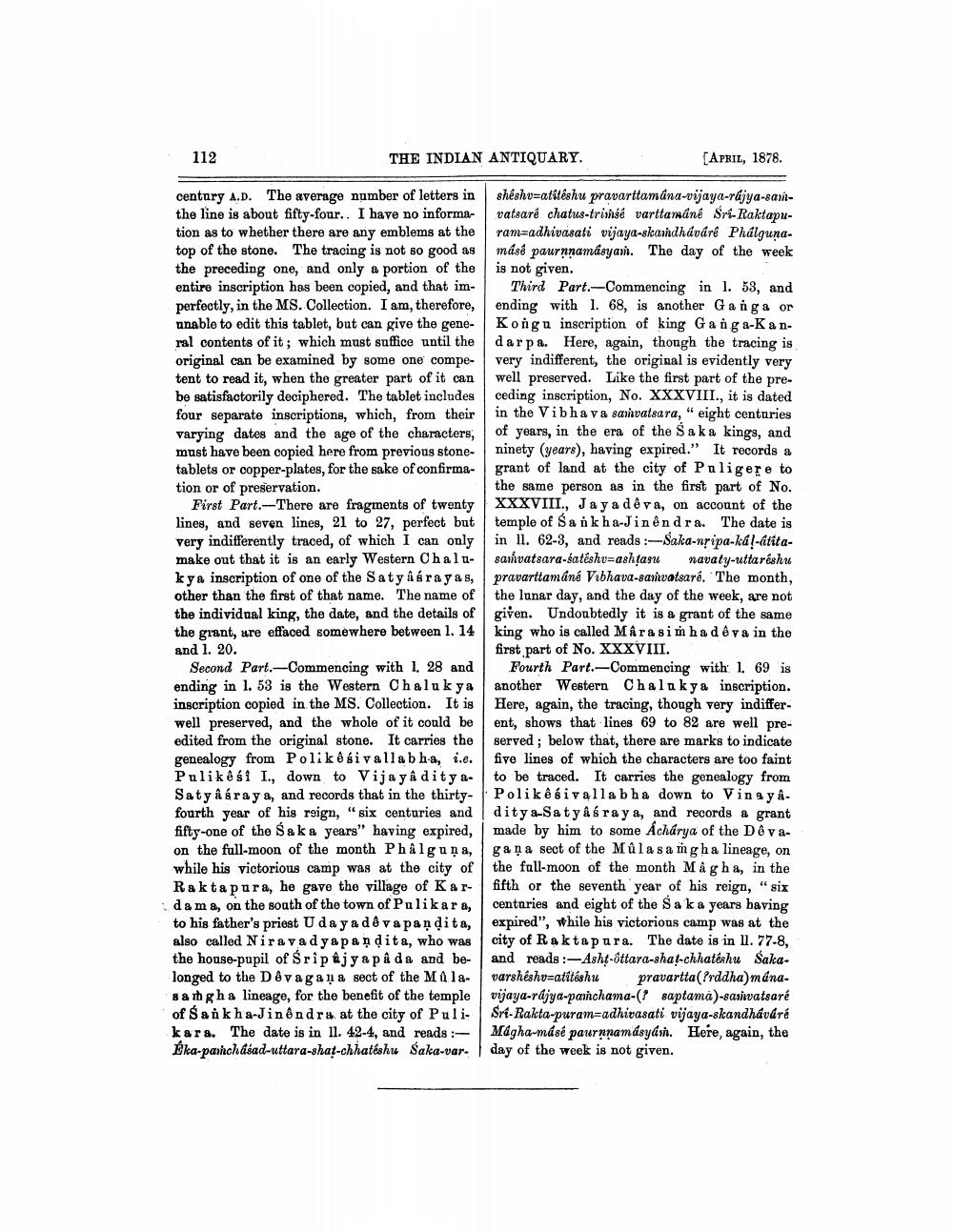________________
112
THE INDIAN ANTIQUARY.
[APRIL, 1878.
century A.D. The average number of letters in sheshv=atitéshu pravarttamána-vijaya-rajya-sarthe line is about fifty-four.. I have no informa- vatsaré chatus-trinse varttarnáné Sri-Raktapution as to whether there are any emblems at the ram-adhivasati vijaya-skarndhávarê Phálgunatop of the stone. The tracing is not so good as mdsé paurnnamásyan. The day of the week the preceding one, and only a portion of the is not given. entire inscription has been copied, and that im- Third Part.--Commencing in l. 53, and perfectly, in the MS. Collection. I am, therefore, ending with 1. 68, is another Ganga or unable to edit this tablet, but can give the gene- Kongu inscription of king Ganga-Kanral contents of it; which must suffice until the darpa. Here, again, though the tracing is original can be examined by some one compe- very indifferent, the original is evidently very tent to read it, when the greater part of it can well preserved. Like the first part of the prebe satisfactorily deciphered. The tablet includes ceding inscription, No. XXXVIII., it is dated four separate inscriptions, which, from their in the Vibhava saivatsara," eight centuries varying dates and the age of the characters, of years, in the era of the Sak a kings, and must have been copied here from previous stone- ninety (years), having expired." It records a tablets or copper-plates, for the sake of confirma- grant of land at the city of Paligere to tion or of preservation.
the same person as in the first part of No. First Part.-There are fragments of twenty XXXVIII., Ja ya dê va, on account of the lines, and seven lines, 21 to 27, perfect but temple of San kh a-Jinên dra. The date is very indifferently traced, of which I can only in Il. 62-3, and reads :-Saka-nripa-kal-lititamake out that it is an early Western Chalu- sannvatsara-satéshv=ashtasu navaty-uttaréshu kya inscription of one of the Satyasrayas, pravarttamáné Vibhava-sauvatsaré. The month, other than the first of that name. The name of the lunar day, and the day of the week, are not the individual king, the date, and the details of given. Undoubtedly it is a grant of the same the grant, are effaced somewhere between 1. 14 king who is called Marasimha deva in the and 1. 20.
first part of No. XXXVIII. Second Part.—Commencing with I. 28 and | Fourth Part.--Commencing with 1. 69 is ending in l. 53 is the Western Chalukya another Western Chala kya inscription. inscription copied in the MS. Collection. It is Here, again, the tracing, though very indifferwell preserved, and the whole of it could be ent, shows that lines 69 to 82 are well preedited from the original stone. It carries the served ; below that, there are marks to indicate genealogy from Polike si vallab h-a, i.e. five lines of which the characters are too faint Pulike si I., down to Vija yâditya- to be traced. It carries the genealogy from Satyasraya, and records that in the thirty- Polik esivalla bha down to Vinayafourth year of his reign, "six centuries and dity a-Satyasraya, and records a grant fifty-one of the Sak a years" having expired, made by him to some Achárya of the Dê vaon the full-moon of the month Phålguna, gana sect of the Mula sa mgha lineage, on while his victorious camp was at the city of the full-moon of the month Magha, in the Raktapura, he gave the village of Kar- fifth or the seventh year of his reign, "six dama, on the south of the town of Palikara, centaries and eight of the Sak a years having to his father's priest U day adê va pandita, expired", while his victorious camp was at the also called Nirav adyapan dita, who was city of Raktapura. The date is in 11. 77-8, the house-pupil of Sripajyapada and be- and reads :--Asht-óttara-shat-chhatéshu Sakalonged to the Dê vagaìa sect of the Mala- varsheshv=atitéshu pravartta(Prddha) manasa mgha lineage, for the benefit of the temple vijaya-rdjya-panchama-(? saptama)-sainvatsaré of Saikh a-Jinêndra at the city of Puli Sri-Rakta-puram=adhivasati vijaya-skandhávaré kara. The date is in 11. 42-4, and reads :- Mágha-másé paurnnamásyan. Here, again, the Eka-parchásad-uttara-shat-chhatéshu Saka-var. day of the week is not given.




